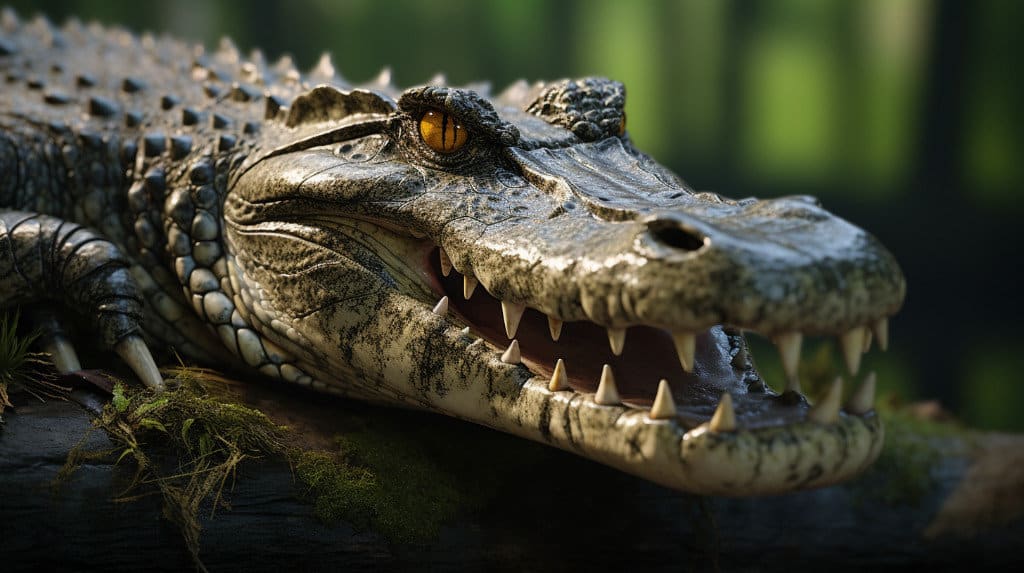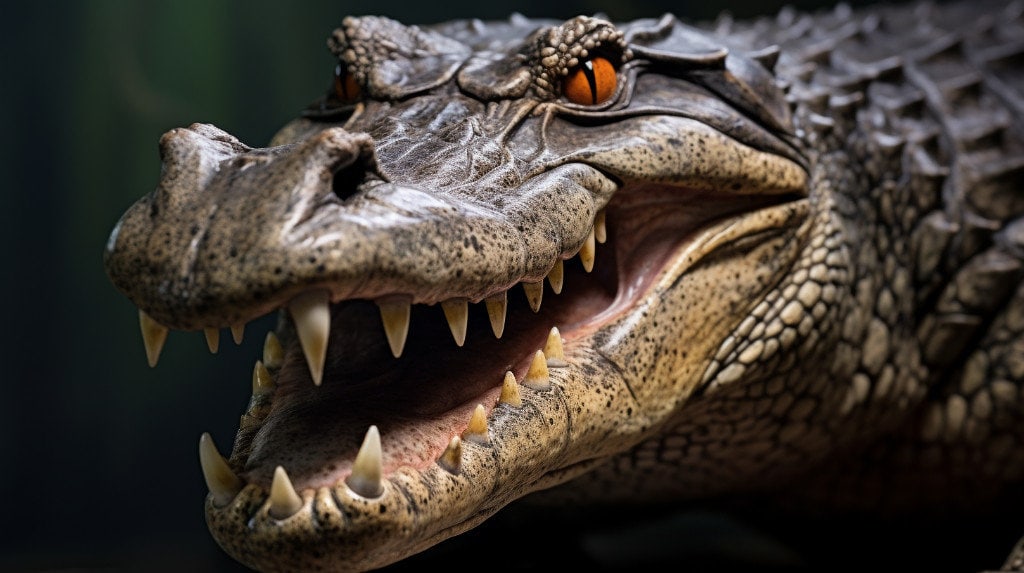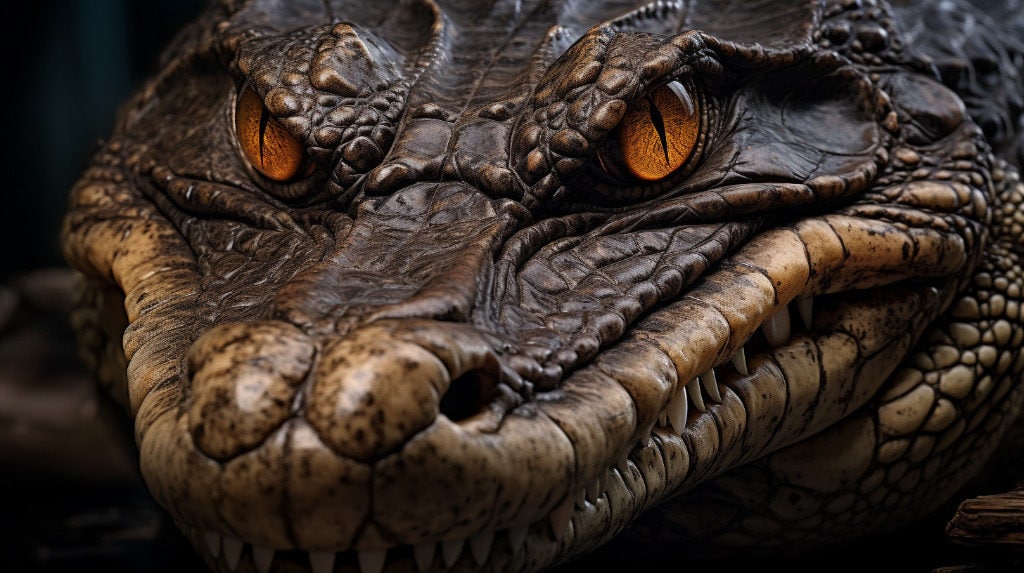Key Takeaways:
Here are some key differences between alligators and crocodiles:
| Alligator | Crocodile |
|---|---|
| Broad, rounded snout | Narrow, pointed snout |
| U-shaped jaw | V-shaped jaw |
| Usually found in freshwater habitats | Can be found in both freshwater and saltwater habitats |
| More tolerant of cooler temperatures | Thrives in warmer climates |
| Generally darker in color | Lighter in color, with a grayish-green hue |
| Teeth in the upper jaw are not visible when the mouth is closed | Teeth in the upper jaw are visible when the mouth is closed |
| Typically less aggressive | Can be more aggressive |
Alligators and crocodiles are often confused with each other due to their similar appearances. However, there are several distinct differences that set them apart. Alligators have a broad, rounded snout, while crocodiles have a narrow, pointed snout. The shape of their jaws also differs, with alligators having a U-shaped jaw and crocodiles having a V-shaped jaw. Alligators are mainly found in freshwater habitats, while crocodiles can be found in both freshwater and saltwater environments. Alligators are more tolerant of cooler temperatures and can survive in regions with colder climates, whereas crocodiles thrive in warmer climates. In terms of color, alligators are generally darker, while crocodiles have a grayish-green hue. Another noticeable difference is that when the mouth is closed, the teeth in the upper jaw of an alligator are not visible, whereas in a crocodile, they are visible. Lastly, alligators are typically less aggressive compared to crocodiles, which can be more aggressive in nature. Understanding these differences can help in correctly identifying these reptiles in their natural habitats.
Taxonomic Differences
Unique Species within Alligator and Crocodile Families
The families Alligatoridae and Crocodylidae encompass a diverse range of species, each with its own distinct characteristics and adaptations. Let’s explore the unique species within these families and understand their taxonomic differences.
Alligatoridae Family
The Alligatoridae family primarily consists of two species: the American alligator (Alligator mississippiensis) and the Chinese alligator (Alligator sinensis). These species are known for their broad snouts and U-shaped jaws. American alligators are found in the southeastern United States, particularly in Florida and Louisiana, while Chinese alligators inhabit the Yangtze River region in China.
American alligators are larger in size compared to their Chinese counterparts, with males reaching lengths of up to 13-15 feet and weighing around 500-600 pounds. Chinese alligators, on the other hand, are smaller, measuring around 5-7 feet in length and weighing about 80-100 pounds. Both species have a dark, armored skin with a rough texture, providing them protection from predators.
Crocodylidae Family
The Crocodylidae family is more diverse, consisting of several species found across different continents. Some notable species include the Nile crocodile (Crocodylus niloticus), the saltwater crocodile (Crocodylus porosus), and the gharial (Gavialis gangeticus).
Nile crocodiles are one of the largest species, with males reaching lengths of up to 16-20 feet and weighing around 500-1,500 pounds. They are found in various parts of Africa, inhabiting rivers, lakes, and marshlands. Saltwater crocodiles, as the name suggests, are adapted to live in saltwater habitats such as estuaries and coastal areas in Southeast Asia and Australia. They are the largest living reptiles, with males reaching lengths of up to 17-23 feet and weighing over 2,000 pounds.
Gharials, on the other hand, have a unique appearance with their long, thin snouts filled with sharp, interlocking teeth. They are primarily found in the rivers of the Indian subcontinent. Gharials are relatively smaller compared to other crocodile species, with males measuring around 14-18 feet in length.
Classification of Alligators and Crocodiles
Alligators and crocodiles belong to the same order, Crocodylia, but are classified into different families. Alligators are classified under the family Alligatoridae, while crocodiles are classified under the family Crocodylidae. This distinction is based on various anatomical and genetic differences between the two groups.
One key difference lies in the shape of their snouts. Alligators have broader, U-shaped snouts, which are well-suited for capturing prey in freshwater habitats. Crocodiles, on the other hand, have narrower, V-shaped snouts, which enable them to catch a wider range of prey, including fish, birds, and mammals, in both freshwater and saltwater environments.
Another distinguishing feature is the arrangement of their teeth. In alligators, the fourth tooth of the lower jaw fits into a socket in the upper jaw, resulting in a hidden tooth when the mouth is closed. In crocodiles, the fourth tooth of the lower jaw remains visible even when the mouth is closed, as it fits into a notch in the upper jaw. This difference is a result of their evolutionary adaptations and can be used to identify the species.
In conclusion, while alligators and crocodiles share similarities as reptiles belonging to the order Crocodylia, they have distinct taxonomic differences. Understanding these differences helps us appreciate the diversity within the animal kingdom and highlights the fascinating adaptations that have evolved over millions of years.
Physical Characteristics
Distinctive features of Alligator and Crocodile heads
Alligators and crocodiles are both fascinating creatures with distinct physical characteristics, particularly when it comes to their heads. Let’s explore the unique features that set them apart:
Alligator Head
The head of an alligator is broad and U-shaped, which gives it a more rounded appearance compared to the crocodile. One of the most prominent features of an alligator’s head is its snout shape. Alligators have a wider and shorter snout, which is perfect for their diet and habitat.
Another distinctive feature of an alligator’s head is its teeth. When an alligator’s mouth is closed, you can only see the upper teeth, as the lower teeth fit into sockets in the upper jaw. This gives them a clean and streamlined look.
Crocodile Head
On the other hand, crocodiles have a more V-shaped head, which is longer and narrower compared to the alligator. The elongated snout of a crocodile is designed for capturing prey in water.
Unlike alligators, when a crocodile‘s mouth is closed, you can see both the upper and lower teeth. The fourth tooth on each side of the lower jaw fits into a notch in the upper jaw, creating a visible interlocking pattern.
Differences in color and skin texture
While alligators and crocodiles may seem similar at first glance, their color and skin texture reveal distinct differences:
Alligators usually have a darker and more olive-colored skin, which helps them blend in with their surroundings in freshwater habitats. Their skin texture is rough and bumpy, with prominent scutes or bony plates.
Crocodiles, on the other hand, have a lighter and more yellowish skin tone. Their skin is smoother and has a more streamlined appearance compared to alligators. This adaptation allows them to move more efficiently in water.
Size difference between Alligators and Crocodiles
Size is another noticeable difference between alligators and crocodiles. Generally, crocodiles tend to be larger than alligators, but there are exceptions depending on the species.
The American alligator, for example, can reach lengths of up to 13 to 15 feet, with males being larger than females. On the other hand, the American crocodile can grow even longer, with males reaching lengths of up to 16 to 18 feet.
In terms of weight, crocodiles are generally heavier compared to alligators. This is due to their larger size and bulkier build.
It’s important to note that these size differences can vary depending on the species and individual variations within each species.
In conclusion, the physical characteristics of alligators and crocodiles provide unique insights into their adaptations and behaviors. Understanding these distinctions allows us to appreciate the diversity within the animal kingdom and the remarkable ways in which different species have evolved to thrive in their respective environments.
Behavioral Differences
When it comes to the animal kingdom, one of the most fascinating aspects to study is the behavior of different species. In this section, we will explore the behavioral differences between alligators and crocodiles, two reptiles that often confuse people due to their similar appearances. Let’s dive in and uncover the distinct behaviors of these magnificent creatures.
Aggression Levels in Alligators and Crocodiles
Both alligators and crocodiles are known for their aggressive nature, but there are some differences in their levels of aggression. Crocodiles tend to be more aggressive compared to alligators. This heightened aggression can be attributed to the crocodile‘s territorial nature and its tendency to defend its territory fiercely. On the other hand, alligators are generally less aggressive and more tolerant of other alligators in their vicinity.
Communication Methods in Alligators and Crocodiles

Communication plays a vital role in the animal kingdom, allowing individuals to convey various messages to their peers. Alligators and crocodiles have different ways of communicating with each other. Alligators mainly communicate through vocalizations, which can range from low-frequency bellows to high-pitched hisses. These vocalizations serve as a means of establishing territory, attracting mates, and warning off potential threats.
Crocodiles, on the other hand, have a more diverse communication repertoire. In addition to vocalizations, they also use body language to convey messages. This includes various postures, such as open-mouth threat displays, head-slapping on the water‘s surface, and even wagging their tails. These visual cues are essential for establishing dominance, attracting mates, and maintaining social hierarchies within their groups.
Differences in Hunting and Feeding Habits
Alligators and crocodiles have distinct hunting and feeding habits, reflecting their evolutionary adaptations and preferred habitats. Alligators primarily inhabit freshwater environments, such as swamps, marshes, and rivers. They are ambush predators, patiently waiting for their prey to come within striking distance. Alligators have a broad snout, which allows them to catch and consume a variety of prey, including fish, turtles, birds, and mammals.
Crocodiles, on the other hand, are more adaptable and can inhabit both freshwater and saltwater habitats. They are opportunistic predators and are known for their stealthy hunting techniques. Crocodiles have a narrow snout, which enables them to snatch prey quickly. Their diet consists of fish, birds, reptiles, and mammals, including larger prey like wildebeests and zebras during migration periods.
To summarize, while alligators and crocodiles share some similarities in their behavior, such as their aggressive nature, they also exhibit distinct differences. Alligators rely more on vocalizations for communication, whereas crocodiles employ a combination of vocalizations and visual cues. Additionally, their hunting and feeding habits differ, with alligators being ambush predators in freshwater environments, and crocodiles being adaptable opportunistic predators in both freshwater and saltwater habitats.
Understanding these behavioral differences enhances our knowledge of these incredible creatures and allows us to appreciate the diversity within the animal kingdom.
Habitat and Geographic Distribution
Adaptations to Different Environments
Animals have evolved various adaptations to survive and thrive in different environments. These adaptations include physical characteristics, behaviors, and physiological changes that allow them to meet the challenges of their habitats. Alligators and crocodiles, for example, have developed unique features that enable them to inhabit diverse ecosystems.
Geographic Distribution of Alligators and Crocodiles
Alligators and crocodiles are reptiles belonging to the order Crocodylia. They are found in various parts of the world, but their geographic distributions differ. Let’s take a closer look at where these fascinating creatures can be found.
Alligators
Alligators are primarily found in the southeastern United States, particularly in states like Florida, Louisiana, Georgia, and Alabama. They inhabit freshwater environments such as swamps, marshes, lakes, and rivers. The warm climate and abundant water sources in these regions provide ideal conditions for their survival.
Crocodiles
Crocodiles, on the other hand, have a wider geographic distribution. They can be found in different parts of the world, including Africa, Asia, Australia, and the Americas. These reptiles are adaptable and can thrive in a variety of habitats, ranging from freshwater rivers and lakes to brackish mangrove swamps and even saltwater estuaries.
Preferred Habitats of Alligators and Crocodiles
While alligators and crocodiles share some similarities in their habitats, they do have distinct preferences when it comes to their chosen environments.
Alligators
Alligators prefer freshwater habitats and are commonly found in slow-moving rivers, swamps, and marshes. They are well-suited to these environments due to their ability to regulate salt levels in their bodies. Freshwater habitats provide them with an abundant supply of prey, including fish, turtles, birds, and mammals.
Crocodiles
Crocodiles, on the other hand, have a broader range of preferred habitats. They can be found in both freshwater and saltwater environments, depending on the species. Some species, like the saltwater crocodile, are known to venture far out into the ocean and can even tolerate high levels of salinity. Others, like the Nile crocodile, inhabit freshwater rivers and lakes.
In conclusion, the habitat and geographic distribution of alligators and crocodiles are influenced by their unique adaptations and environmental requirements. While alligators are primarily found in the southeastern United States and prefer freshwater habitats, crocodiles have a wider distribution and can inhabit both freshwater and saltwater environments. Understanding these differences allows us to appreciate the diverse ecosystems that these incredible reptiles call home.
Alligators, Crocodiles, and Caimans

Introduction to Caimans
Caimans are fascinating reptiles that belong to the same family as alligators and crocodiles. They are native to Central and South America and are known for their unique characteristics and behaviors. Let’s delve into the world of caimans and explore what sets them apart from their close relatives.
Caimans are smaller in size compared to alligators and crocodiles, with an average length ranging from 4 to 8 feet. They have a broad snout and a more compact body structure. One distinguishing feature of caimans is the bony ridge that runs along their snout, giving them a distinct appearance.
These reptiles are well-adapted to their aquatic habitat. They have webbed feet, which aid in swimming and maneuvering through the water. Caimans also possess sharp teeth that are ideal for catching and gripping onto their prey. Their diet primarily consists of fish, birds, and small mammals.
Differences and Similarities between Alligators, Crocodiles, and Caimans
While alligators, crocodiles, and caimans share similarities due to their common ancestry, there are several key differences that set them apart.
1. Physical Appearance
Alligators have a broad, U-shaped snout, whereas crocodiles have a longer, V-shaped snout. Caimans, on the other hand, have a more compact snout with a bony ridge. Additionally, alligators and caimans have a darker coloration, while crocodiles tend to have a lighter, olive-green color.
2. Habitat
Alligators are found in freshwater habitats, such as swamps, lakes, and rivers, primarily in the southeastern United States and parts of China. Crocodiles, on the other hand, have a broader distribution and can be found in both freshwater and saltwater habitats across the world. Caimans are mostly found in Central and South America, inhabiting rivers, streams, and flooded forests.
3. Behavior
Alligators are generally less aggressive compared to crocodiles. They are known for their territorial behavior, especially during the mating season. Crocodiles, on the other hand, can be more aggressive and are known to be opportunistic hunters. Caimans exhibit similar behaviors to alligators, being less aggressive overall.
4. Size
Crocodiles are the largest of the three, with some species reaching lengths of up to 20 feet. Alligators are smaller, with the largest species, the American alligator, reaching lengths of around 13 to 15 feet. Caimans are the smallest, with an average length ranging from 4 to 8 feet.
5. Geographic Distribution
Alligators are primarily found in the southeastern United States and parts of China. Crocodiles have a much broader distribution, inhabiting regions in Africa, Asia, the Americas, and Australia. Caimans are native to Central and South America.
In conclusion, alligators, crocodiles, and caimans are fascinating reptiles with unique characteristics and behaviors. While they may share similarities, such as being semi-aquatic and belonging to the same family, they also have distinct features that make each species special. Understanding these differences allows us to appreciate the rich diversity within the animal kingdom.
Conservation Status and Threats
Current conservation status of Alligators and Crocodiles
Alligators and crocodiles are fascinating creatures that have captured the attention of humans for centuries. However, these magnificent reptiles face numerous conservation challenges due to human activities and environmental changes.
Alligators
Alligators, which are native to the southeastern United States, have made a remarkable recovery since being listed as an endangered species in the 1960s. Thanks to dedicated conservation efforts, their population has rebounded, and they are now classified as a species of “Least Concern” on the International Union for Conservation of Nature (IUCN) Red List.
Crocodiles
Crocodiles, on the other hand, have a more varied conservation status due to their wide distribution across different regions of the world. Some species, such as the Saltwater Crocodile, are classified as “Least Concern,” while others, like the Philippine Crocodile, are critically endangered. The conservation status of crocodile species depends on factors such as habitat loss, hunting, and climate change.
Conservation efforts for Alligators and Crocodiles
Conservation efforts for alligators and crocodiles are crucial to ensure the long-term survival of these species. Here are some of the initiatives that have been undertaken:
Habitat protection
Preserving the natural habitats of alligators and crocodiles is essential for their survival. Wetlands, marshes, and swamps provide these reptiles with suitable nesting sites, food sources, and shelter. Efforts are being made to protect and restore these habitats, ensuring the availability of suitable environments for alligator and crocodile populations.
Captive breeding programs
Captive breeding programs play a significant role in the conservation of alligators and crocodiles. These programs aim to breed these reptiles in controlled environments, ensuring genetic diversity and providing individuals for reintroduction into the wild. By carefully managing captive populations, scientists and conservationists can help boost the numbers of these species.
Legislation and regulations
Implementing and enforcing laws and regulations to protect alligators and crocodiles is crucial. These laws often prohibit hunting, trade, and exploitation of these reptiles and their habitats. By having legal protections in place, governments can deter illegal activities and promote conservation efforts.
Threats faced by Alligators and Crocodiles
Despite conservation efforts, alligators and crocodiles continue to face various threats that put their populations at risk. Some of the significant threats include:
Habitat loss and degradation
Human activities, such as urbanization, agriculture, and deforestation, have led to the loss and degradation of alligator and crocodile habitats. Wetland drainage, pollution, and habitat fragmentation disrupt their natural ecosystems, making it challenging for these reptiles to find suitable nesting sites and food sources.
Illegal hunting and poaching
Alligators and crocodiles are often hunted illegally for their skins, meat, and body parts, which are highly valued in the illegal wildlife trade. Poaching not only reduces their populations but also disrupts their ecological roles within their habitats.
Climate change
Climate change poses a significant threat to alligators and crocodiles. Rising temperatures and sea levels can impact their nesting sites and alter their natural habitats. Changes in precipitation patterns and extreme weather events can also affect their ability to find food and survive.
In conclusion, the conservation status of alligators and crocodiles varies depending on the species and the regions they inhabit. While conservation efforts have helped to protect and recover populations, ongoing threats such as habitat loss, hunting, and climate change require continuous attention and action. By raising awareness, implementing conservation measures, and promoting sustainable practices, we can contribute to the long-term survival of these incredible reptiles.
Human Interactions and Impact

Impact of Human Activities on Alligator and Crocodile Populations
Human activities have had a significant impact on the populations of alligators and crocodiles around the world. These reptiles, which have been around for millions of years, are now facing numerous threats due to human actions. Let’s take a closer look at some of the ways in which human activities have affected these fascinating creatures.
Habitat Destruction
One of the most significant impacts of human activities on alligator and crocodile populations is habitat destruction. As human populations expand and urban areas grow, natural habitats are being cleared to make way for agriculture, infrastructure, and residential development. Wetlands, marshes, and other freshwater habitats that serve as crucial habitats for these reptiles are being drained or degraded.
Alligators and crocodiles rely on these habitats for breeding, nesting, and finding food. The destruction of their habitats not only disrupts their natural behaviors but also leads to a decline in their populations. Efforts to preserve and restore these habitats are crucial for the long-term survival of alligators and crocodiles.
Illegal Hunting and Poaching
Another significant threat to alligator and crocodile populations is illegal hunting and poaching. The demand for their skins, meat, and other body parts drives illegal hunting activities. These reptiles are often killed for their valuable skins, which are used in the fashion industry to make luxury products.
Poaching not only reduces the population of these reptiles but also disrupts the delicate balance of ecosystems they inhabit. Alligators and crocodiles play essential roles in their respective ecosystems by regulating prey populations and maintaining the health of wetland habitats. The illegal trade in their body parts must be addressed through strict law enforcement and public awareness campaigns.
Pollution and Contamination
Pollution and contamination of water bodies also pose a threat to alligator and crocodile populations. Chemical runoff from agricultural practices, industrial waste, and improper disposal of chemicals can contaminate the water sources these reptiles rely on. This pollution can lead to various health issues, including reproductive problems and weakened immune systems.
Additionally, plastic pollution has become a growing concern for alligators, crocodiles, and other marine life. These reptiles can mistake plastic debris for food, leading to ingestion and potential harm. Efforts to reduce pollution and promote proper waste management are essential for the conservation of these species.
Alligator and Crocodile Encounters with Humans
Alligators and crocodiles occasionally come into contact with humans, leading to encounters that can be both fascinating and potentially dangerous. Understanding how to interact with these reptiles is crucial for ensuring the safety of both humans and the animals themselves.
Avoiding Conflict
When encountering an alligator or crocodile in the wild, it is important to remember that they are wild animals and should be treated with caution and respect. Keeping a safe distance is essential, as these reptiles can be unpredictable and may perceive humans as threats.
It is advisable to never approach or feed alligators or crocodiles in their natural habitats. Feeding them can lead to habituation, where they become accustomed to human presence and associate humans with food. This can increase the likelihood of dangerous encounters and potentially lead to the animals being euthanized due to safety concerns.
Coexistence and Conservation
Despite the potential risks associated with encounters, it is possible for humans and alligators/crocodiles to coexist. Many areas with healthy populations of these reptiles have implemented measures to ensure human safety while conserving these species.
Educational programs and signage in areas where alligators or crocodiles are present can help raise awareness about their behavior and the importance of respecting their habitats. By understanding their natural behaviors and taking necessary precautions, humans can minimize the risk of negative encounters and contribute to the conservation of these remarkable reptiles.
Importance of Alligators and Crocodiles in Human Culture
Alligators and crocodiles hold significant cultural and ecological importance for many human societies around the world. Throughout history, these reptiles have been revered, feared, and even worshipped in various cultures.
Cultural Significance
In many indigenous cultures, alligators and crocodiles are considered sacred animals and are often featured in myths, legends, and religious ceremonies. They symbolize strength, power, and resilience. The Nile crocodile, for example, holds great cultural significance in ancient Egyptian mythology.
These reptiles have also influenced art, literature, and popular culture. They have been depicted in ancient cave paintings, featured in folklore and fairy tales, and portrayed in movies and books. Their iconic features, such as their armored skin and powerful jaws, have made them fascinating subjects for artistic interpretation.
Ecological Importance
Beyond their cultural significance, alligators and crocodiles play crucial ecological roles in the ecosystems they inhabit. They are apex predators, helping to regulate prey populations and maintain the balance of their habitats. Their presence in wetlands and freshwater ecosystems contributes to the overall health and biodiversity of these areas.
Furthermore, alligators and crocodiles act as indicator species, reflecting the overall health of their habitats. By monitoring their populations and behaviors, scientists can gain valuable insights into the state of the ecosystems they inhabit. Protecting these reptiles helps preserve the delicate balance of their habitats and ensures the health of other species that depend on these ecosystems.
In conclusion, human interactions and activities have had both positive and negative impacts on alligators and crocodiles. Habitat destruction, illegal hunting, pollution, and encounters with humans pose significant threats to the survival of these reptiles. However, by raising awareness, implementing conservation measures, and respecting their habitats, we can ensure the coexistence of humans and these remarkable creatures for generations to come.
Conclusion
In conclusion, while alligators and crocodiles may seem similar at first glance, there are several key differences that set them apart.
Alligators are generally found in freshwater habitats such as swamps, lakes, and rivers, primarily in the southeastern United States and parts of China. They have a wider, U-shaped snout and are darker in color. Alligators have a more limited tolerance to saltwater and tend to avoid it.
On the other hand, crocodiles are found in both freshwater and saltwater habitats, including rivers, lakes, estuaries, and coastal areas. They have a narrower, V-shaped snout and are lighter in color. Crocodiles have a higher tolerance to saltwater and can be found in marine environments.
Additionally, when it comes to behavior, alligators are generally less aggressive and more tolerant of humans compared to crocodiles. Crocodiles, on the other hand, are known to be more aggressive and territorial.
Overall, understanding these differences can help us appreciate the unique characteristics and adaptations of these fascinating reptiles.
Frequently Asked Questions
What is the difference between Alligators and Crocodiles?
The primary differences between Alligators and Crocodiles lie in their physical features and habitats. Alligators have a U-shaped snout and are usually found in freshwater habitats, while Crocodiles have a V-shaped snout and are commonly found in saltwater environments.
What are the differences in size between an Alligator and a Crocodile?
Crocodiles are generally larger than Alligators. The average size of a male crocodile can reach up to 5-6 meters, while a male alligator typically grows up to 3-4 meters.
How are the teeth of Alligators and Crocodiles different?
The fourth tooth in a Crocodile’s lower jaw is visible even when its mouth is closed, while in Alligators, this tooth is hidden.
How does the color difference between Alligators and Crocodiles manifest?
Alligators are usually darker in color, often black, while Crocodiles tend to be lighter, usually olive brown or gray.
What is the difference between the snouts of Alligators and Crocodiles?
Alligators have a broader, U-shaped snout, while Crocodiles have a narrower, V-shaped snout.
How do Alligator and Crocodile behaviors differ?
Crocodiles tend to be more aggressive than Alligators. Alligators, unless provoked or cornered, usually avoid interactions with humans.
What is the difference between the habitats of Alligators and Crocodiles?
Alligators are typically found in freshwater environments like ponds and marshes, while Crocodiles prefer saltwater habitats such as coastal regions and estuaries.
How do the eyes of Alligators and Crocodiles differ?
Alligators’ eyes are larger and rounder compared to the more almond-shaped eyes of Crocodiles.
What is the difference between Alligator and Crocodile skin?
Crocodile skin is rougher and has more pronounced scales compared to the smoother skin of an Alligator.
Which is more dangerous, an Alligator or a Crocodile?
Crocodiles are generally considered more dangerous due to their aggressive nature and larger size. However, both can pose significant threats if provoked or threatened.




